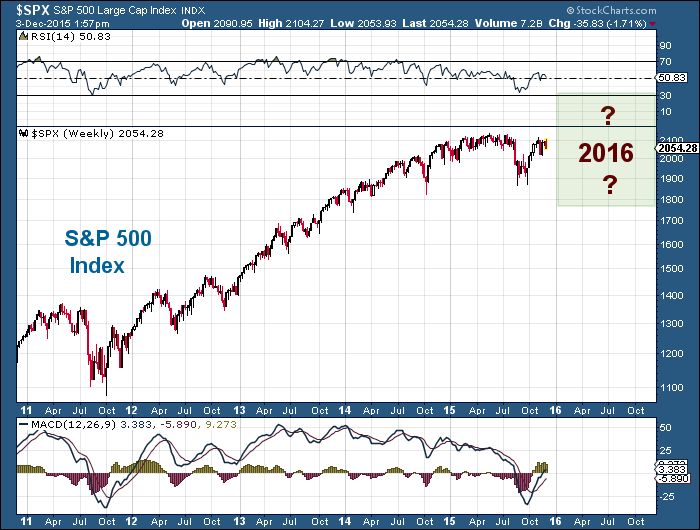One of my favorite television shows right now is The Blacklist on NBC. The main character in this spy thriller, Raymond Reddington, is prone to deliver thought-provoking monologues that have many applications outside of the fictional drama. One of the more recent episodes focused on the concept of trying to predict or count on a specific outcome in the future.
You see, if you were a betting man, you would understand that now trumps later every time. The future is a sucker’s bet– a maybe, a contingency, a “What if?” The only thing that is real is the present. -Raymond Reddington, The Blacklist, NBC
These lines immediately came to mind when I started reading the 2016 market predictions from major banks. Goldman Sachs is forecasting that the market will finish next year near the flat line, while Bank of America is striking a slightly more optimistic tone with a conservative 4-5% gain.
These banks employ legions of bright minds with incalculable modeling power to come out with these forecasts. Yet at the end of the day, I would venture to guess there is probably a small clan of stodgy economists and market watchers who put together these “firm views”. It may ultimately be more of a gut feeling rather than a true analysis of the exponential variables involved.
I think it’s important to remember that the stock market doesn’t care what your price target is. And therefore investors need to be ready for anything while investing in 2016.
Check out the chart below. 2016 looks pretty lonely. We’ll be there soon enough, and having a process, a plan, and strong discipline will go a long ways in making you more successful with your investing in 2016.
2016 is also likely to be the year that investors see the first real impact of fiscal tightening in nearly a decade. Don’t forget that we are also going to be electing a new president next year as well. Those are just the major events we KNOW are coming. Add in the countless rounds of corporate earnings, economic data releases, government policy, social trends, and other unforeseeable events and the picture becomes quite murky. These components are what make up the “wall of worry” that stocks are so famous for scaling.
I don’t have a precise view on where we are going to finish 2016. I’m more focused on the process it will take to successfully navigate my clients’ portfolios to that end zone. That means focusing on the present and the facts or variables we have in front of us right now rather than the best guesses of Wall Street’s elite. Price is the ultimate arbiter of reality. And it’s important to remember while preparing for 2016 and investing in 2016.
I will certainly have some favored vehicles that I plan on entering the year with and will share those in an upcoming post. However, like all good plans, it may require some modest adjustments as conditions change along the way. There are going to be areas of the portfolio that will need to be trimmed or bolstered in order to keep the ship steady in continuously swirling seas.
Even buy-and-hold investors will be forced to do some soul searching on what to do with dividends, when to re-balance, or what adjustments may be needed to their overall asset allocation. Focusing on the things that are in your control will create a stable platform to build and compound your wealth no matter what the stock market does from year to year.
If you feel like you have been coasting by to this point or aren’t as adequately prepared with an investment plan as you should be, start by following some of these concepts to help you prepare for investing in 2016:
- Define your goals. This is one of the first things I ask new clients. Determine a realistic rate of return and write it down. That way you can benchmark if you are on track to meet your goal and can visualize an objective that you are working towards. The key word in this bullet point is “realistic”. Everyone wants 20% compounded returns with no risk, but in the real world that doesn’t exist. For some the goal may be capital preservation with just a couple of percent upside, while others may desire significant growth of 10% or more. That number will guide the risk that you will need to take in order to achieve a satisfactory outcome.
- Review your prior results. Take a step back for a moment and calculate your returns relative to a benchmark over the last several years. Determine if you have been able to maintain correlation with the market, have outperformed, or fallen short of your goals. This will help identify any structural flaws with your current investment structure. Common areas of weak performance include high fees, unconventional asset classes, and poor investment advice. This self-examination exercise will automatically provoke the impulse for change if your results have been underwhelming.
continue reading on the next page…









